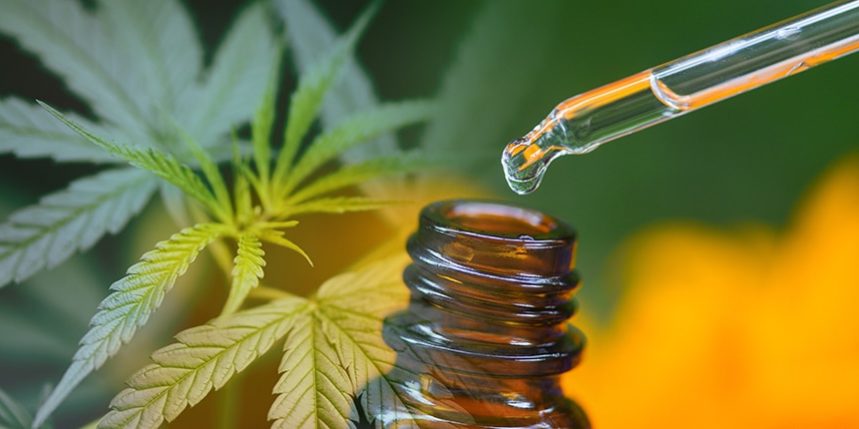
Theoretically, CBD should not show up on a drug test. However, because most CBD products are classified as a supplement, it is not regulated for safety and purity. This means that contamination of the CBD with THC (tetrahydrocannabinol) may and does occur, and this may show up on a drug test, depending on the cutoff level of the test and other factors listed below.
This is more likely to happen if the CBD you are buying is marijuana-derived CBD rather than hemp-derived CBD. Hemp-derived CBD is required by law to contain less than 0.3% THC, although regular daily ingestion of high doses of this may still cause THC to accumulate.
Broad-spectrum CBD is also less likely to be contaminated with THC. This is because all the THC is removed in broad-spectrum CBD as opposed to full-spectrum CBD which contains all of the compounds that naturally occur in the plant they were extracted from. CBD isolate is also pure CBD, and typically comes from hemp so it shouldn’t contain THC.
If you want to pass a drug test, don’t take CBD; or if you are taking it legally within your State’s laws, then declare it (however it still may be contaminated with THC unless brought by a reputable supplier who guarantees it to be THC-free).
How much THC needs to be present to cause a positive drug test?
It is difficult to say how much THC needs to be present to cause a positive drug test because this depends on several drug and patient-specific variables, and also the cutoff value for the test.
The following variables affect the amount of time that marijuana (THC) and its metabolites remain detectable in the urine or other biological samples:
- Frequency of marijuana use (the half-life of THC is 1.3 days for an infrequent user and 5-13 days for frequent users)
- Presence of interacting drugs
- How much is used and the route of administration
- Last time of ingestion.
Several patient factors can also affect the result, such as body mass, urine pH, urine concentration and other medical conditions such as kidney or liver disease.
An estimate of the length of time marijuana (THC) is detectable in urine is:
- Single-use: 3 days
- Moderate use (4 times/week): 5 to 7 days
- Chronic use (daily): 10 to 15 days
- Chronic heavy use: More than 30 days.
Federal workplace cutoff values for marijuana metabolites are 50 ng/mL for immunoassay screening tests (one ng is a billionth of a gram). In a confirmatory test, a metabolite of marijuana is measured, called delta-9-tetrahydrocannabinol-9-carboxylic acid, and a positive test result is above 15 ng/mL. However, this can vary depending on the variables listed above and should not be relied upon to ensure a drug-free result.
Other Things to Know About Workplace Drug Testing
Despite the widespread use of urine drug tests, there appears to be some inconsistency in the interpretation of test results. Considering the significant consequences a false-positive result can have (such as loss of job or imprisonment), this is somewhat surprising. But it is also something to be aware of, because it may mean that what is considered a pass (a negative result) in some circumstances may be considered a fail (a positive result) in others.
Drug testing can be conducted on various biological specimens, such as urine, hair, blood, saliva, sweat, toenails, fingernails, and meconium. Urine drug testing is the most common way of workplace testing for specific drugs because it is not invasive, and samples are easy to collect.
Drug tests either test for the parent drug or at least one of its metabolites, or both. Concentrations of drugs in urine are usually higher than in blood and present for longer.
There are two main types of urine drug tests: screening and confirmatory tests. Immunoassay screening tests can be conducted on-site (point of care testing) or in a laboratory and allow large numbers of tests to be performed at once with relatively rapid results, providing an initial estimate of the presence or absence of drugs. There are three main types available, and all use antibodies to detect the presence of specific or classes of drug metabolites. Unfortunately, this can mean that substances with similar characteristics may be detected, resulting in false-positive results.
Some visual point of care tests are favored by pain management clinics or by clinicians treating people with substance misuse disorders. However, at times the results may be difficult to read (such as a faint color or an uncertain color) which can result in a subjective interpretation. These tests should only be considered preliminary and a follow up confirmatory laboratory test should be conducted, as with any screening test; however, this best practice may not always be followed.
Confirmatory tests (Drug of Abuse Panel tests) use gas chromatography/mass spectrometry to identify specific molecular structures and to quantify the amount of drug or a substance present in the sample. These are more accurate than screening tests, but are also more costly and time-consuming and are usually reserved for situations that have significant legal, academic, forensic, or employment sequelae. These recognize cannabinoids rather than metabolites so should be able to distinguish CBD from THC.
Cut-off levels were established to help minimize false-positive results especially in workplace drug testing (for example, passive inhalation of marijuana; eating poppy seeds on bread causing positive opiate results) and these tend to be higher than those used by clinical laboratories.




